Canon G7X Review
The Canon G7X "super compact" enters the scene for underwater photography. For almost 3 years, the Sony RX-100 series has reigned unchallenged as the king of compacts, particularly for underwater photography. Tiny in size, great in image quality - it quickly became a popular choice. Now the Canon G7X is challenging the RX-100 III as a potential choice for aspiring photographers. Find out if it is right for you.
The Canon G7X has a 1-inch sensor, the same sensor as the Sony RX-100 II & III, and is about the same size as those 2 cameras. It is 20% lighter than the Canon G16, and smaller. It is quite a pleasure to hold and operate, and it features the easy to use and understand Canon menu system found in their other compact cameras.
Canon G7X key specs for underwater:
20 Megapixel sensor
24-100mm F1.8-2.8 lens (very bright!)
Aperture range F1.8 - F11
ISO Range ISO 125 - 12,800
2 inch min. focal distance at wide focal lengths
Weight with battery, 304 grams
Full manual controls, shoots in RAW
Flash power can be set to TTL or manual power level
Dimensions 103 x 60 x 40 mm (4.06 x 2.36 x 1.57 inches)
Battery life is CIDA rated 210 shots, 310 shots in "eco" mode
Canon G7X - key comparisons for underwater photography
Compared to the Canon G16, the G7X offers almost as good of macro capability, but in addition offers a larger sensor, more megapixels (20 vs 12), and TTL capability with strobes in manual mode, which was definitely missed by many G-series users.
Compared to the Sony RX-100 III, the G7X offers slightly faster shot to shot times when using the flash to trigger the strobes, and better macro capability - while producing the same high quality images.
DxoMark sensor tests give the Canon G7X a score of 71, with color, DR, and low-light coming in at 23bits, 12.7evs, and 556 ISO respectively. This is slightly higher than the RX-100 III score or 67, 22.4, 12.3evs, 495 ISO.
Canon G7X video review
Underwater Photography Guide and Bluewater Photo owner Scott Gietler reviews the Canon G7x on video, along with a couple of underwater housings available for it.
Canon G7X - macro capability
The macro capability is almost as good as the Canon G-series cameras, and noticeably better than the Sony RX-100 III, with or without a macro lens. It is recommended to shoot at F11 for maximum depth of field when using a wet macro lens.
MACRO - with no macro lens, showing the smallest width of a photo the camera can take. A smaller distance is better.
Canon G7x - 1.5 inches (you are getting very close to the subject)
Canon G16 - 1.5 inches (you are getting very close to the subject)
Sony RX-100 III - 3.5 inches
MACRO - with the Bluewater +7 macro lens, showing the smallest width of a photo the camera can take. A smaller distance is better.
Canon G7x - 1.2 inches
Canon G16 - 1 inch
Sony RX-100 III - 1.75 inches
Canon G7X - wide angle wet lenses
Because of the 24-100mm lens, the housing does not work well with many wide-angle lenses that were designed for 28mm cameras. Lenses such as the Dyron Super-Wide lens and the Inon UWL-H100 lens will work but may require zooming in slightly, depending on the housing. Results with both the Recsea and the Recsea CW housing in the pool were quite good, the image was about 2.5 times as wide with the Dyron lens than without. It was necessary to zoom in 2 clicks to eliminate a small amount of vignetting in the corners. Results with a wet lens will be a little wider on the Sony RX-100 III, and even wider on the Sony RX-100 I or II.

Canon G7X, Recsea housing, no wet lens at 24mm

Canon G7X, Recsea housing, Dyron super wide-angle, zoomed in 2 clicks
Canon G7X - auto-focus speed
I tested the auto-focus speed on the Canon G7X in both low-light conditions, and in macro mode. I found the results to be quite good for a compact camera, at least as good as the Sony RX-100 III, or perhaps slightly better. Shooters upgrading from a G-series or S-series Canon compact will definitely notice a difference. However, the camera still does not match the focusing speed of the more recent mirrorless cameras.
Canon G7X - TTL and flash recycle speed
The Canon G7X can do TTL with Sea & Sea and Inon strobes via fiber optics and using its internal flash. The flash setting on the menu must be set to "auto", which is the default. The flash can also be set to manual power, and has a min, medium, and max power setting.
Flash recycle time is fairly good when the flash is on the minimum power setting, about 1 second in between shots. However, on max power, there is a noticely delay in between shots, about 5 seconds long.
Canon G7X low light performance
Low light performance is great, better than a regular compact and on par with many mirrorless cameras. Check out the great looking photo I took inside my place at ISO 1600. Extensive "lab" results of high ISO performance can be found on sites such as dpreview.

"Tree of decals", F4, 1/40th, 24mm, ISO 1600

Canon G7X ISO 1600 test - 100% crop taken from the photo above it
Canon G7X underwater video
The underwater video of the Canon G7X is quite nice, check out the sample video taken in low-visibility water at Catalina Island in California.
Canon G7X underwater housings
Housings are currently available from Ikelite and Recsea, with underwater housings from Nauticam and Fantasea expected soon. The Recsea CW, Fantasea and Ikelite housings are less expensive, polycarbonate housings, while the Recsea aluminum & Nauticam housings are more expensive, finely crafted aluminum underwater housings with precise controls.
We tested both the Recsea G7X housing, and the less expensive polycarbonate Recsea CW GX7 housing, and found both housings excellent in quality and controls, offering great options at two price points and good wet lens options for both macro & wide-angle.
The Nauticam G7X housing will be announced soon, and will feature a changeable port so a "short port" can be added on land.
G7X underwater housings from Ikelite, Nauticam and Fantasea will be tested soon upon arrival.
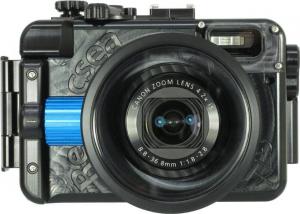
Recsea G7X housing $849
This is the smallest available aluminum housing.
Purchase the Recsea Canon G7X Housing on Bluewater Photo
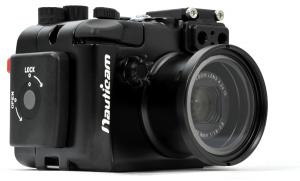
Nauticam G7X housing $1100
Another well-made aluminum housing with excellent ergonomics, and a short port option for incredible wide-angle with wet lenses.
Purchase the Nauticam Canon G7X Housing on Bluewater Photo
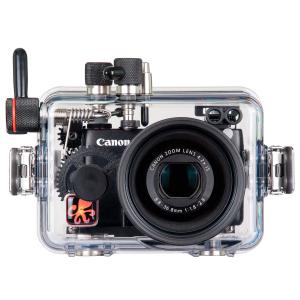
Purchase the Ikelite Canon G7X Housing on Bluewater Photo
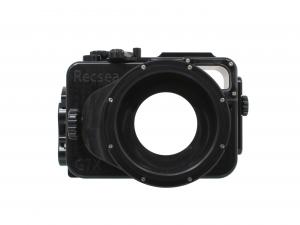
Recsea G7X CW housing
This tiny polycarbonate housing at $550 is a best buy.
Purchase the Recea Canon G7X CW Housing on Bluewater Photo
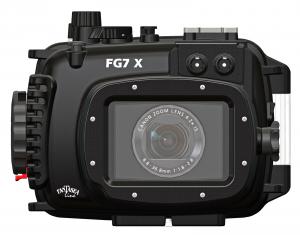
Fantasea G7X housing
This polycarbonate housing at $399 is a great value. and is very reliable. Add the camera for just $499 more!
Purchase the Fantasea Canon G7X Housing on Bluewater Photo
Read Bluewater Photo's Fantasea Canon G7X Housing Review.
Conclusions
The Canon G7X will be a popular choice for photographers who are fans of the G-series or S-series Canon compacts, but are looking for a little better image quality & focus speed, while maintaining a very small setup underwater.
Its main "cons" are a shorter battery life than its competitors, and the lack of ability to use a fisheye lens.
The Canon G7X will excel in macro, fish and ambient light shots, while also being able to take decent wide-angle underwater photos. Overall, we highly recommend you take a serious look at this newcomer in the underwater photography field.
Sample Photos Shot with the Canon G7 X

(learn more about the Nauticam CMC-1 macro diopter)


RECOMMENDED ARTICLES
SUPPORT THE UNDERWATER PHOTOGRAPHY GUIDE:
The Best Service & Prices on u/w Photo Gear
 Visit Bluewater Photo & Video for all your underwater photography and video gear. Click, or call the team at (310) 633-5052 for expert advice!
Visit Bluewater Photo & Video for all your underwater photography and video gear. Click, or call the team at (310) 633-5052 for expert advice!
The Best Pricing, Service & Expert Advice to Book your Dive Trips
 Bluewater Travel is your full-service scuba travel agency. Let our expert advisers plan and book your next dive vacation. Run by divers, for divers.
Bluewater Travel is your full-service scuba travel agency. Let our expert advisers plan and book your next dive vacation. Run by divers, for divers.



































